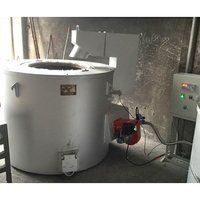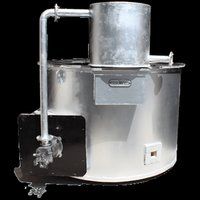






Crucible Furnace
110000 INR/Unit
Product Details:
- Condition New
- Usage Melting Furnace
- Voltage 220-440 Volt (v)
- Application melting aluminum and copper alloys
- Click to view more
X
Crucible Furnace Price And Quantity
- 1 Unit
- 110000.00 - 250000.00 INR/Unit
- 110000 INR/Unit
Crucible Furnace Product Specifications
- Melting Furnace
- 220-440 Volt (v)
- melting aluminum and copper alloys
- New
Crucible Furnace Trade Information
- JNPT Port
- Letter of Credit (L/C), Letter of Credit at Sight (Sight L/C), Telegraphic Transfer (T/T), Cheque
- 10 Unit Per Month
- 4 Week
- Australia, Western Europe, Middle East, Africa, Central America, South America, Asia, Eastern Europe, North America
- All India
Product Description
With rich industry experience, we are offering an assorted gamut of Crucible Furnace. The given furnace finds usage in many industries and is widely used in the melting process of gold, platinum, silver and other noble metals. This product is widely demanded for its robust construction, corrosion resistance, enhanced durability, long working life and low maintenance features. Manufactured and designed as per standard specifications, this sturdily build product can also be customized as per the requirements of our esteemed customers.
Crucible Furnace FAQ:
What is a crucible furnace?
A crucible furnace is a type of furnace used for melting and heating materials at high temperatures. It consists of a refractory crucible, typically made of ceramic or graphite, which holds the material to be melted, and a heating element, such as an electric coil or gas burner, which provides the heat.
What materials can be melted in a crucible furnace?
Crucible furnaces are capable of melting various materials, including metals (e.g., aluminum, copper, gold), glass, ceramics, and certain types of plastics. The choice of material depends on the furnace's design and temperature capabilities.
How do crucible furnaces work?
Crucible furnaces work by applying heat directly to the crucible containing the material to be melted. The heating element generates heat, which is transferred to the crucible and the material inside. As the temperature rises, the material melts and can be poured or shaped as needed.
What are the different types of crucible furnaces?
Crucible furnaces can be classified based on their heating method, fuel source, and application. Common types include electric resistance crucible furnaces, gas-fired crucible furnaces, induction crucible furnaces, and laboratory muffle furnaces.
What are the temperature capabilities of crucible furnaces?
Crucible furnaces can reach temperatures ranging from several hundred degrees Celsius to over 2000 degrees Celsius, depending on the furnace's design, heating elements, and insulation. Some specialized crucible furnaces can even reach temperatures exceeding 3000 degrees Celsius for specific applications.
What safety precautions should be taken when using crucible furnaces?
Safety precautions when using crucible furnaces include wearing appropriate personal protective equipment (PPE), such as heat-resistant gloves and eye protection, ensuring proper ventilation to prevent exposure to fumes, and following manufacturer's instructions for operation and maintenance.
How do I choose the right crucible furnace for my application?
When selecting a crucible furnace, consider factors such as the type and size of materials to be melted, required temperature range, heating method (electric, gas, or induction), energy efficiency, available space, and budget. Consulting with a knowledgeable supplier or manufacturer can help you choose the best furnace for your needs.
What maintenance is required for crucible furnaces?
Regular maintenance of crucible furnaces includes cleaning the crucible and furnace chamber, inspecting heating elements and insulation for wear or damage, replacing worn parts as needed, and ensuring proper calibration of temperature controls for accurate temperature regulation.
Can crucible furnaces be used for recycling materials?
Yes, crucible furnaces are commonly used for recycling scrap metals, glass, and other materials by melting them down for reuse. They are efficient for melting and purifying recycled materials, making them valuable tools for recycling operations.
Are crucible furnaces environmentally friendly?
Crucible furnaces can be environmentally friendly when operated efficiently and used for recycling materials, as they help reduce the need for new raw materials and minimize waste. However, like any industrial process, proper waste management and pollution control measures are essential to minimize environmental impact.
Tell us about your requirement

Price:
Quantity
Select Unit
- 50
- 100
- 200
- 250
- 500
- 1000+
Additional detail
Mobile number
Email
Other Products in 'Special Purpose Equipments' category













 Send Inquiry
Send Inquiry Send SMS
Send SMS
